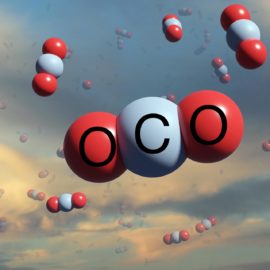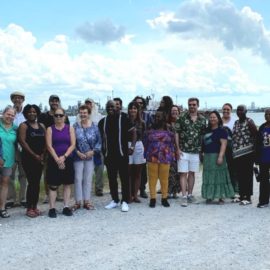
Not fully repaired from Ida and another hurricane seacon coming, what is it iike if you live in Cancer Alley.
On a rainy Saturday in September 2021, Robert Taylor’s home in Reserve, La. was abuzz with volunteers in respirators and hazmat suits. As they cycled in and out of the house, arms filled with moldy drywall or hauling sleds of mud and debris, Taylor recounted how he and his wife spent years building this home, saving their paychecks to buy lumber and screws. Then Hurricane Ida made landfall in Louisiana in late August, tearing Taylor’s roof off in a matter of minutes. Rain and mold took most of their possessions over the next few days. Nearly two years since the storm, the Taylors are still in the process of rebuilding their home. I’ve been working as a climate organizer in Louisiana since 2019. After Ida, a group of organizers and environmental justice leaders started coordinating disaster relief, even though none of us had ever tarped a roof or gutted a house. It was work that needed to be done, so we learned how to do it. Following months of rapid response via connections made through hot meal distributions and supply giveaways, we formalized into the Louisiana Just Recovery Network (LJRN). LJRN now has three full-time staff. Though we continue to coordinate roof replacements and home rebuilds, the mission has expanded beyond rapid response to incorporate skills training, preparedness, and community outreach, with a goal of providing meaningful work for rural Louisianans—especially those living in“Cancer Alley,” the strip of the state from Baton Rouge through New Orleans that is overrun by refineries, pipelines, and chemical plants. As we approach the 2023 hurricane season, I spoke with LJRN leaders and community partners to hear their reflections on the road to recovery from Ida.
southerlymag.org
Robert Taylor, Concerned Citizens of St. John the Baptist
We evacuated for Ida, and before we returned I saw pictures of our house that showed the roof was taken off. I was devastated. A contractor wanted $14,000 to gut our home, but Louisiana Just Recovery Network and SBP came out to do it for free. I don’t even know what we would have done if not for them. On 31st Street in Reserve, La., every home has had multiple deaths from cancer. The hurricane only worsened our conditions. It wasn’t until Ida that I came into awareness of the petrochemical industry’s double whammy: environmental racism and climate change. There are people in my community who still refuse to call out the plants. They’re afraid to “bite the hand that feeds,” but they don’t realize that hand is feeding us poison. If we address environmental racism, we will address the climate crisis. The root cause of climate change is the petrochemical industry’s disregard for human life in its constant chase for greater profits. We may be in Cancer Alley, but the plants that compromise our air also compromise the future of our planet. That affects everybody. Our communities are treated as a sacrifice zone for industry. They put the Denka plant right on top of my house, and then they ask why we don’t leave. I built my home with my bare hands so that I would have wealth to pass down to my children. I believe my family has a God-given right to remain in our community.” Reserve is a historic Black community in southeast Louisiana. It is home to Denka Performance Elastomer (a plant formerly owned by DuPont), the only facility in the nation that produces the likely carcinogen chloroprene, a chemical used to make the synthetic rubber neoprene. Residents in the census tract closest to Denka face a cancer risk 50 times higher than the average American, according to a 2019 study by University Network for Human Rights. In December 2022, the U.S. Environmental Protection Agency announced it will take action to address environmental pollution from Denka.
Melissa Bright, Louisiana Just Recovery Network
My dad had just gotten out of the hospital with COVID when Ida came and badly damaged our family home. Meeting Louisiana Just Recovery Network was a new experience. They were helping people more than our parish (county) officials. A key lesson I’ve learned is to check on your elderly folks. A homeowner I worked with had a government phone that got turned off after the storm, so she had no way of communicating with the outside world. Even if someone is not responding over the phone, drive by and check on them. See what they’re going through and how you can be of assistance. I recently began working full-time for LJRN as a community organizer, coordinating several of our rebuild projects. It’s been hectic, but I enjoy it. The smile on the homeowners’ faces, the gratefulness and appreciation they show once they are back in their homes — that’s reward enough for me.
Dominic Kruger, Louisiana Just Recovery Network
I got involved with Louisiana Just Recovery Network through my old friend Melissa. After I got injured I couldn’t go back to work in the plants, but I still wanted to work, so I volunteered my time to fix up Melissa’s parents’ house. It felt good to lay the floors down, do the trim and help people get back home. After that first house, I was hooked. A lot of younger guys in this area live off the streets, in what I call “abandoned neighborhoods” that have been left behind. There are few jobs available here so they have to do what they can to feed their families, good or bad. But if you’ve gotten in trouble and have a record, even if you’ve done your time, you’re still stigmatized. You can’t go work in the plants even if you want to. But you can work in construction, and it’s a growing industry. Hurricanes are going to keep coming, and they’ll get worse, so there will always be work to rebuild communities. Roofing, sheet rock, carpentry, flooring, trim. Once you have those skills, you can go anywhere. You don’t have to kill yourself in a plant, inhaling chemicals, getting hurt. Our neighborhoods die when the plants come in. There used to be small businesses in my community, but pollution has forced them out. When you take away stores and schools, we’re left with nothing. I hope LJRN will continue to grow and become better prepared for future storms. I want to bring communities back, not watch them fade away. FEMA’s average payout for Hurricane Ida victims is $1,060 per claim, according to the agency. Research shows Black hurricane victims often receive less aid than white residents, even when their homes experience the same level of damage. Louisiana has the second largest Black population in the US, and 14 major hurricanes have made landfall in the state since 2000. Disaster cleanup is now a $200 billion industry, so sustainable construction and disaster response are growing opportunities for employment.
Jo Banner, The Descendants Project
The goal of the Descendants Project is to make our community less vulnerable. We will never stand on the sidelines and refuse our duty to respond to disaster. Sometimes that means distributing supplies and generators. Sometimes that means creating long term initiatives to invest in education and workforce development. In spite of the challenges, I see so many wonderful things about our community. We’re called Cancer Alley, but we’re far more than that. We have so much here to protect—the beauty of the water and wetlands, our wildlife and our cultural heritage. There is a lot of work to be done, but we have so much potential. Progress is being made. My ancestors walked off the plantations. They survived the battlegrounds of the Civil War. After emancipation they returned to the land, invested in it and built our community. I am here today because of the powerful legacy they’ve left. I want to make sure we preserve this land for the generations that will come after me. We were here before the petrochemical industry, and we’ll be here after.
Thank you Pastor Manning for sending this to me to post. Not what we here from here.



